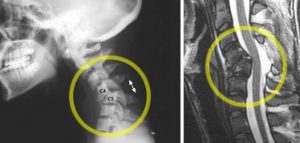Interesting study on fluoroscopy and intervertebral-motion (IV-RoM)
Does IV range-of-motion increase after spinal manipulation? A prospective cohort study.
Branney J et al Chiropractic and Manual therapies 2014
Conclusions: “The study found NO differences in cervical IV-ROM between non-specific neck pain patients and matched controls. There was a modest dose-response relationship between the number of manipulations given and number of levels increasing IV-RoM, suggesting manipulation may have a mechanical effect at segmental levels. However patient-reported outcomes were NOT related to this”.
Discussion: The prevalence of both hypo-mobile and paradoxical segments was also subject to considerable intra-subject variation. 4 of 22 hypo-mobile segments remained so at follow-up with 8 new hypo-mobile segments detected. Only 8 out of 25 paradoxical segments remained so at follow-up with 4 new levels detected.
Hypo-mobility is commonly considered an indication for manipulation. Due to the changing nature of these motion-features….hypo-mobility or paradoxical motion in response to manipulation may not be possible or meaningful.


